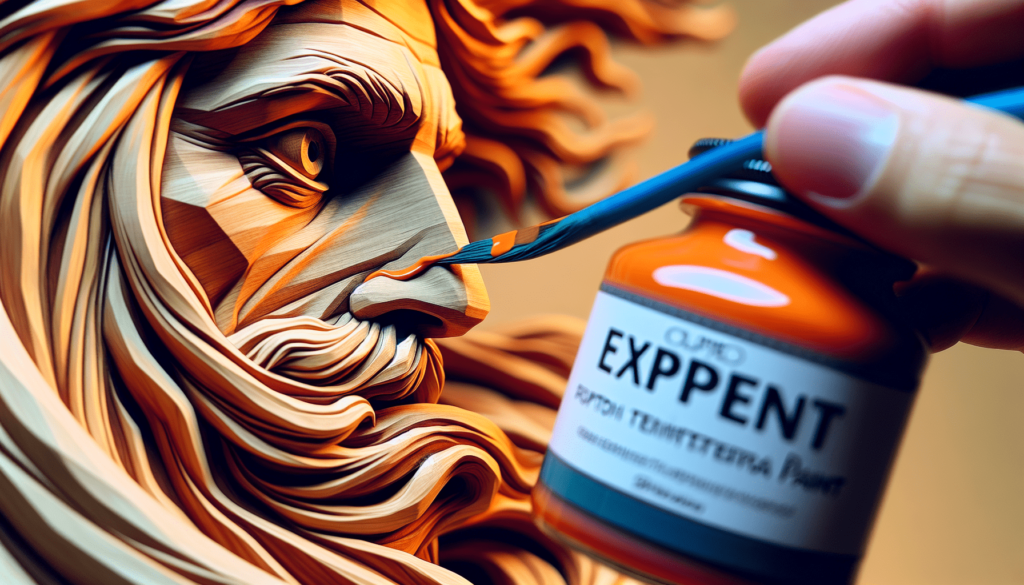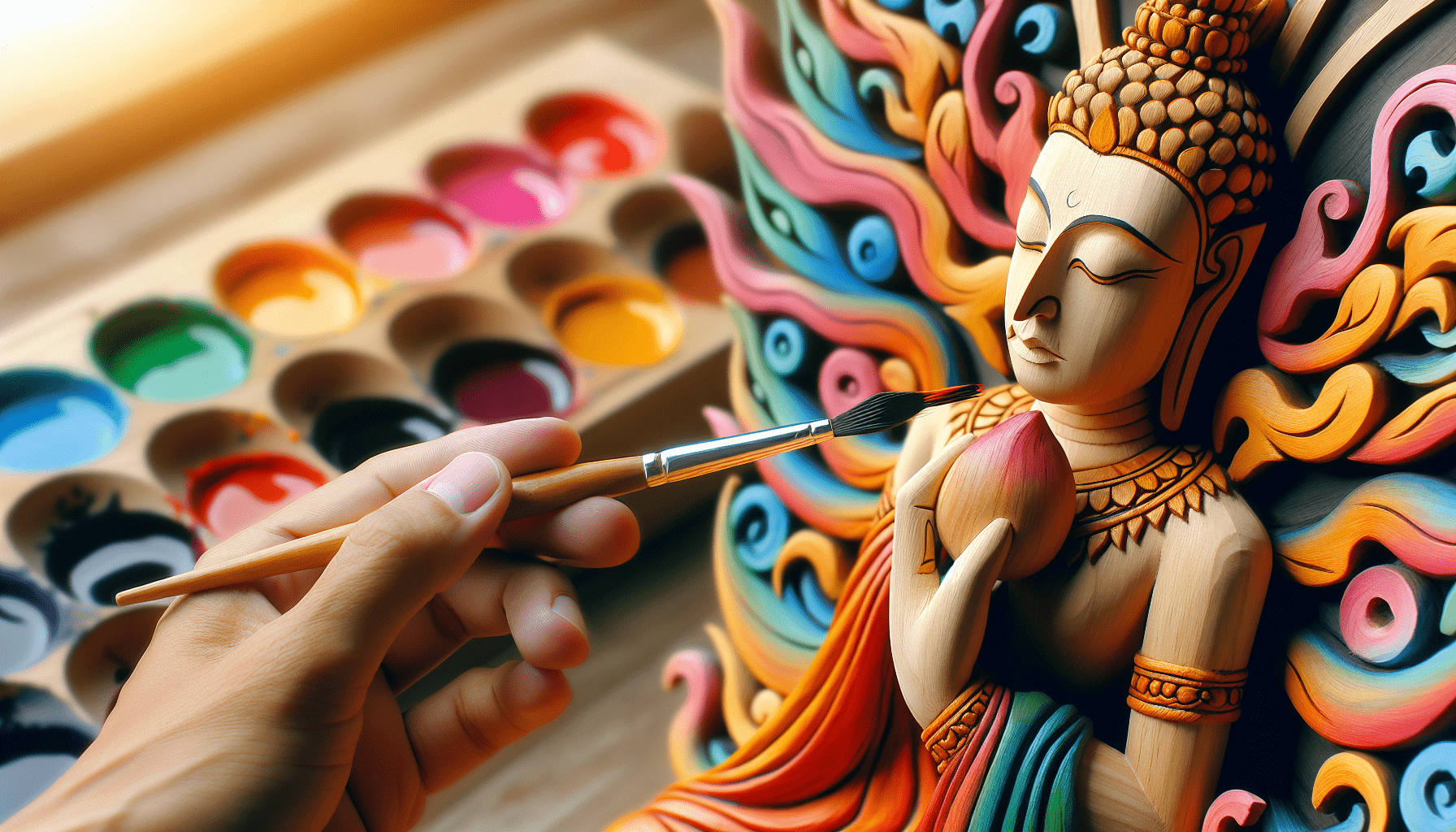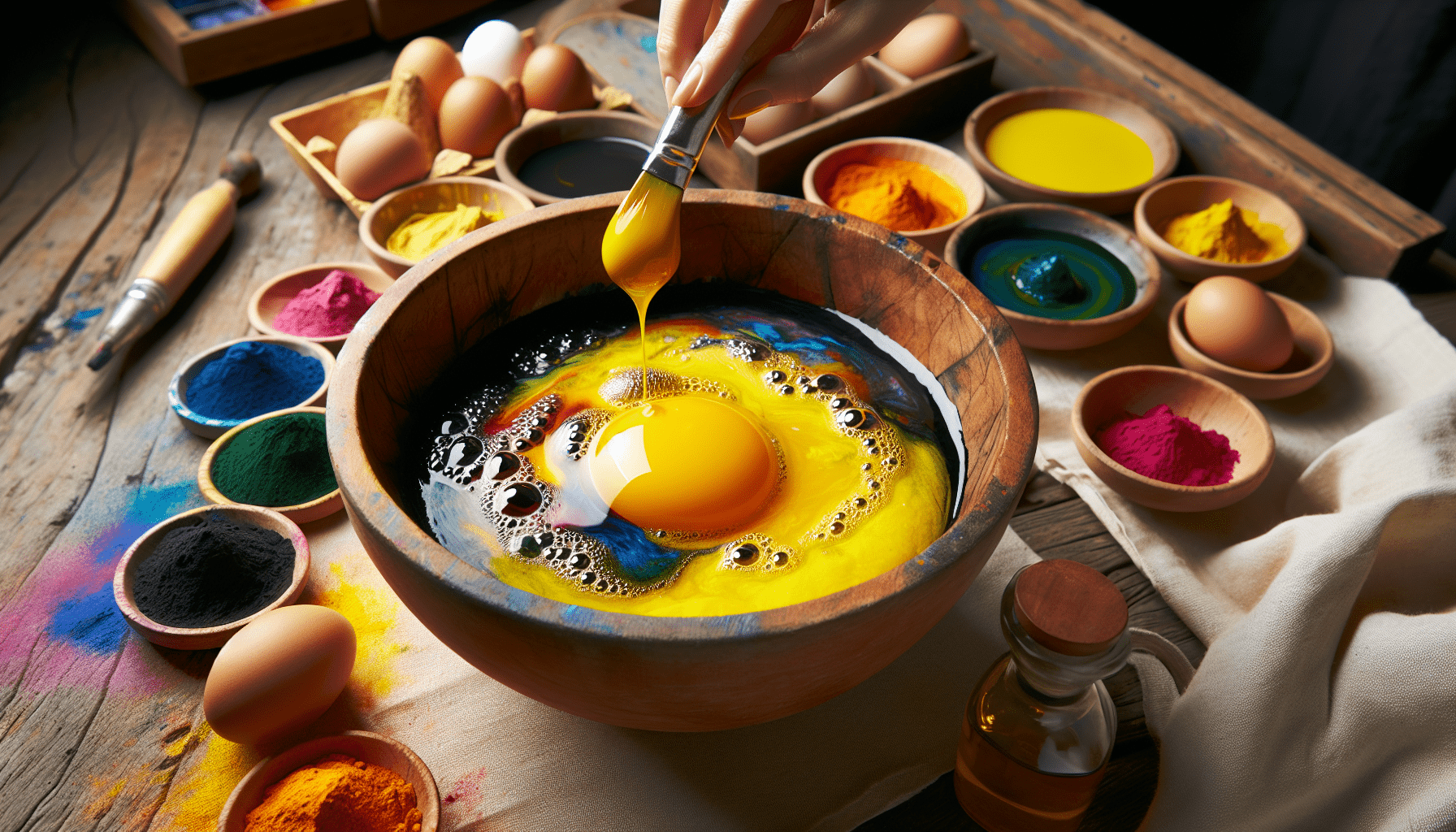Tempera paint is a popular choice for various art projects due to its vibrant colors and easy application. However, when it comes to using tempera paint on wood, you may be wondering if it is a suitable medium. This article explores the compatibility of tempera paint with wood surfaces, addressing concerns related to durability, adhesion, and finish. Discover the advantages and limitations of using tempera paint on wood, allowing you to make informed decisions and achieve stunning artistic results.

Introduction
Explanation of tempera paint
Tempera paint is a type of water-based paint that is made by mixing pigments with a binder, usually egg yolk or another type of emulsion. It has been popular for centuries and is known for its vibrant colors and smooth finish. Tempera paint dries quickly and is easy to work with, making it a versatile choice for various artistic projects.
Importance of choosing the right paint for wood
When it comes to using paint on wood surfaces, it is crucial to choose the right type of paint to ensure optimal adhesion, longevity, and durability. Using an unsuitable paint can result in poor coverage, peeling, or chipping, which can ruin the appearance and integrity of the wood. Therefore, it is essential to understand the compatibility of tempera paint with wood and how to properly prepare the surface before painting.
Brief overview of using tempera paint on wood
Using tempera paint on wood can be a great option for both artistic and practical purposes. Whether you are creating a masterpiece on a wooden canvas or looking to add some color to a wooden furniture piece, tempera paint offers excellent versatility. This article will provide a comprehensive guide on using tempera paint on wood, including its properties, compatibility with wood surfaces, preparation techniques, application methods, sealing, longevity considerations, alternative options, and tips for a successful painting experience.
Understanding Tempera Paint
Definition and composition of tempera paint
Tempera paint is a water-based paint that has been used for centuries in various artistic applications. The word “tempera” is derived from the Latin word “temperare,” meaning “to mix.” Traditionally, it consists of pigments mixed with a binder that can be easily dispersed in water, such as egg yolk, gum arabic, or casein. These binders help bind the pigments together and adhere to the painting surface. Modern variations of tempera paint may use synthetic binders instead of traditional organic ones.
Properties of tempera paint
Tempera paint possesses several notable properties that make it a popular choice among artists. Firstly, it has a smooth and creamy consistency, which allows for easy application and layering. It dries quickly, usually within a few minutes to a few hours, depending on environmental conditions. Once dry, tempera paint forms a durable and matte finish. It is also known for its high-pigment concentration, resulting in vibrant and opaque colors.
Advantages and disadvantages of tempera paint
Tempera paint offers several advantages that make it appealing for use on wood surfaces. Firstly, it is non-toxic and has a low odor, making it safe to use in enclosed spaces. Secondly, it has excellent lightfastness, meaning it resists fading and discoloration over time. Additionally, tempera paint is relatively inexpensive compared to other types of paints. However, it does have certain limitations. It is not as flexible as acrylic or oil paints, resulting in potential cracking on highly flexible wood surfaces. It is also sensitive to moisture and may not withstand prolonged exposure to water or humid environments.
Compatibility with Wood
Factors to consider for paint and wood compatibility
When considering the compatibility of tempera paint with wood, several factors come into play. Firstly, the porosity and surface texture of the wood can affect how well the paint adheres and absorbs. Secondly, the movement and flexibility of the wood can impact the integrity of the paint layer. Lastly, the presence of any existing coatings, such as varnish or stain, can influence the adhesion and compatibility of tempera paint.
Absorption and adhesion properties of tempera paint on wood
Tempera paint tends to adhere well to wood surfaces, especially if the wood is properly prepared. However, the absorption rate of the wood can affect how the paint behaves. Wood that absorbs moisture quickly may cause the paint to dry more rapidly, making it challenging to work with. Conversely, wood with low absorption may prevent the paint from drying sufficiently, leading to longer drying times and potential smudging.
Effects of different wood surfaces on tempera paint
The type of wood surface plays a significant role in how tempera paint performs. Paint may behave differently on softwoods, such as pine or cedar, compared to hardwoods like oak or mahogany. Softwoods are generally more porous and may require additional preparation steps, such as sealing or priming, to achieve a smooth and even paint application. Hardwoods, on the other hand, tend to have a denser structure, making them less absorbent and more resistant to moisture, which can be beneficial for tempera paint application.
Preparing Wood for Tempera Paint
Importance of proper wood preparation
Properly preparing the wood surface is crucial to ensure the best results when using tempera paint. Wood that is not adequately prepared may not provide a suitable foundation for the paint, resulting in adhesion issues, poor coverage, or an uneven finish. Preparation involves cleaning the wood, addressing any surface imperfections, and creating a smooth, dust-free surface for the paint to adhere to.
Cleaning and sanding techniques
Before applying tempera paint, it is important to clean the wood surface thoroughly. This is done to remove any dirt, dust, oils, or other contaminants that may hinder paint adhesion. A mild detergent or wood cleaner can be used along with a soft brush or sponge to gently scrub the surface. Once the wood is clean and dry, sanding is recommended to create a smooth and even surface. Sandpaper with a medium grit can be used to remove any roughness or imperfections, ensuring optimal paint adhesion.
Priming or sealing wood before applying tempera paint
In some cases, it may be beneficial to prime or seal the wood before applying tempera paint. Priming helps create a barrier between the wood and the paint, improving adhesion, and preventing wood tannins or stains from bleeding through the paint. A suitable primer for wood, such as a water-based acrylic primer, can be applied evenly using a brush or roller. Alternatively, a wood sealer can be used to seal the wood pores and create a smoother surface for the paint to adhere to. Both priming and sealing can enhance the durability and longevity of the paint on wood.

Application Techniques
Choosing appropriate brushes or tools
Selecting the right brushes or tools for applying tempera paint on wood is essential for achieving the desired results. The choice of brush depends on the size of the project and the level of detail required. For larger areas, a flat brush or foam brush may be suitable, while smaller areas or intricate details may require a round or liner brush. It is important to choose brushes with synthetic bristles specifically designed for use with water-based paints. This ensures that the bristles do not absorb excessive amounts of water or become too soft, affecting the paint application.
Applying tempera paint on wood
When applying tempera paint to wood, it is best to start with thin, even layers. This allows for greater control and helps prevent the paint from pooling or streaking. The paint can be applied using a brush, sponge, or even a palette knife, depending on the desired effect. It is important to work quickly and avoid excessive brushing or overlapping, as this can disturb the underlying layers and cause unevenness. If desired, multiple layers can be applied once the previous layer is completely dry.
Layering and blending techniques
One of the advantages of tempera paint is its ability to create smooth and well-blended gradient effects. This can be achieved by layering and blending different colors on the wood surface. To create a layered effect, allow each layer to dry completely before adding the next layer. Blending can be done by gently overlapping and feathering adjacent colors while they are still wet. This technique can create a seamless transition between colors and add depth and dimension to the finished painting.
Sealing and Protecting the Paint
Necessity of sealing tempera paint on wood
Sealing the tempera paint on wood is crucial for protecting the painting from various environmental factors and ensuring its longevity. Without proper sealing, the paint may be susceptible to moisture damage, fading, or staining. Sealing also provides a protective barrier that enhances the overall durability of the paint, making it less prone to scratches or abrasions. Additionally, sealing can enhance the vibrancy and color saturation of the paint, giving it a more polished and professional appearance.
Types of sealers for tempera paint
There are various types of sealers that can be used to protect tempera paint on wood. A common option is a clear acrylic varnish, which creates a transparent protective layer while enhancing the colors and finish. Another option is a water-based polyurethane varnish, which provides a durable and moisture-resistant coating. It is important to choose a sealer that is compatible with tempera paint and suitable for wood surfaces.
Methods for applying sealers
When applying sealers to tempera paint on wood, it is important to follow the manufacturer’s instructions and use the appropriate techniques. The sealer can be applied using a brush, roller, or spray applicator, depending on personal preference and the size of the project. It is recommended to apply thin, even coats and allow each coat to dry completely before applying additional layers. This ensures optimal adhesion and a smooth finish, free of brush marks or bubbles.
Considerations for Longevity
Factors affecting the durability of tempera paint on wood
Several factors can affect the longevity of tempera paint on wood. Firstly, exposure to direct sunlight or high levels of UV radiation can cause the paint colors to fade over time. Therefore, it is advisable to display or store the painted wood in areas away from direct sunlight. Secondly, moisture and humidity can impact the integrity of the paint layer, potentially leading to cracking or peeling. Ensuring proper sealing and avoiding prolonged exposure to moisture can help mitigate these issues. Lastly, physical factors such as abrasion, impact, or improper handling can also affect the durability of the paint.
Tips for maintaining and preserving tempera paint on wood
To maintain and preserve the longevity of tempera paint on wood, it is important to handle the painted surface with care. Avoid placing heavy objects on the painted wood, as this can cause indentations or damage the paint. Regular dusting or light cleaning with a soft, dry cloth can help prevent the buildup of dirt or debris that may degrade the paint over time. If the paint shows signs of wear or damage, touch-up painting can be done using the same techniques and materials as the initial painting process.
Recommended usage and display conditions
To ensure the longevity and vibrancy of tempera paint on wood, it is recommended to display the painted surface in controlled environments with stable temperature and humidity levels. Extreme temperature fluctuations or high humidity can cause the wood to expand or contract, potentially leading to paint cracking or peeling. Additionally, avoiding areas with excessive moisture, such as bathrooms or kitchens, can prolong the integrity of the paint. It is also important to display the painted wood away from direct sunlight or artificial lighting that emits UV radiation, as this can cause gradual color fading.
Alternative Paint Options for Wood
Overview of other paint types suitable for wood
While tempera paint is a suitable option for painting on wood, there are other types of paints that can also be used for wood surfaces. Acrylic paint, for example, offers similar advantages to tempera paint, such as water-based properties and quick drying time. Oil-based paints provide a smoother and more glossy finish, but they require longer drying times and may have stronger odors. It is important to consider the specific requirements of the project and the desired outcome when choosing an alternative paint for wood.
Comparison of advantages and disadvantages with tempera paint
Comparing alternative paint options with tempera paint can help determine the best choice for a particular wood project. Acrylic paint, for instance, provides greater flexibility, allowing it to withstand wood movement and prevent cracking. Oil-based paints offer excellent durability and a glossy finish, but they may require additional ventilation due to their stronger odors. Tempera paint remains a popular choice for its ease of use, affordability, and vibrant colors, making it suitable for various art and decorative applications.
Exploring different finishes and effects
Beyond the choice of paint type, exploring different finishes and effects can add uniqueness and visual interest to the painted wood surface. Various techniques, such as distressing, antiquing, or applying decorative glazes, can be used to create different textures and appearances. Experimenting with different brush strokes, layering, or stenciling techniques can also add depth and dimension to the painted wood. It is recommended to practice these techniques on a sample piece of wood before applying them to the final project to ensure the desired effect is achieved.
Tips and Precautions
Safety precautions while using tempera paint
While tempera paint is generally considered safe to use, it is essential to take certain safety precautions to ensure a healthy painting experience. It is advisable to work in a well-ventilated area or use a paint booth to minimize exposure to fumes. If ventilation is limited, wearing a respiratory mask or using a portable air filtration system can help reduce inhalation of paint particles. It is also recommended to wear protective gloves to prevent skin irritation and to avoid contact with eyes or mouth. If accidental ingestion or contact occurs, seek medical attention immediately.
Storing and disposing of tempera paint properly
Proper storage and disposal of tempera paint are important to maintain its quality and minimize environmental impact. When storing tempera paint, ensure the containers are tightly sealed to prevent the paint from drying out or becoming contaminated. It is best to store the paint in a cool, dry place away from direct sunlight or extreme temperatures. If disposing of leftover paint, consult local regulations or waste management authorities for proper disposal methods. It is generally recommended to dry out small amounts of paint before disposing of them in regular trash bins.
Troubleshooting common issues during painting
During the painting process, you may encounter common issues that can be easily resolved with the proper techniques. If the paint appears streaky or uneven, try applying thinner coats of paint or using a different brush to create a smoother finish. If the paint is not adhering properly to the wood, ensure that the surface is properly prepared and consider using a primer or sealer. If the paint starts to crack or peel after drying, it may indicate an issue with wood movement or moisture. Addressing these issues promptly can help achieve the desired results and prevent future problems.
Conclusion
Summary of using tempera paint on wood
Using tempera paint on wood provides a versatile and vibrant option for various artistic and decorative projects. Understanding the properties and compatibility of tempera paint with wood surfaces is essential for achieving optimal results. Proper wood preparation, including cleaning, sanding, and priming, ensures a smooth and durable painting surface. Applying the paint in thin layers, using appropriate brushes or tools, and employing layering and blending techniques can create stunning effects. Sealing the paint and considering factors affecting longevity are vital for preserving the artwork on wood.
Final thoughts and recommendations
Tempera paint offers a multitude of creative possibilities on wood surfaces. Its ease of use, affordability, and vibrant colors make it an appealing choice for artists and DIY enthusiasts. However, it is essential to consider the specific requirements of the project and the desired outcome. Exploring alternative paint types, finishes, and effects can open doors to endless possibilities in wood painting. By following proper techniques, taking necessary safety precautions, maintaining the painted wood, and addressing any issues promptly, you can achieve beautiful and long-lasting results with tempera paint on wood.



